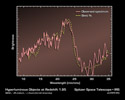
Figure 1This graph, or spectrum, shows the light from a dusty, distant galaxy located 11 billion light-years away. The galaxy is invisible to optical telescopes, but NASA's Spitzer Space Telescope was able to capture the light from it and dozens of other similar galaxies using heat-seeking infrared eyes.
Spectra are created when an instrument called a spectrograph spreads light out into its basic parts, like a prism turning sunlight into a rainbow. They contain the signatures, or "fingerprints," of molecules that contribute to an object's light.
In this case, the galaxy's spectrum reveals the fingerprint for silicate dust (large dip at right), a planetary building block like sand, only smaller. This particular fingerprint is important because it helped astronomers determine how far away the galaxy lies, or more specifically, how much the galaxy's light had stretched, or "redshifted," during its journey to Spitzer's eyes. Because the universe is expanding, a galaxy's light will shift toward reddish wavelengths as it moves away from us. This galaxy was found to have a redshift of 1.95, which means that its light took about 11 billion years to get here.
The presence of the silicate fingerprint is also significant because it implies that galaxies were ripe for planetary formation 11 billion years ago - back to a time when the universe was 3 billion years old. The universe is currently believed to be 13.5 billion years old. This is the furthest back in time that silicate dust has been detected around a galaxy.
These data were taken by Spitzer's infrared spectrograph in July, 2004.

